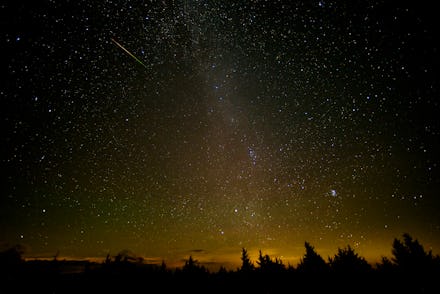Perseid Meteor Shower: What to know about the annual celestial event

Summer skygazers are in for a treat Monday night as the the Perseid meteor shower kicks off.
The annual celestial event, which features hundreds of tiny meteors lighting up the night sky, is visible until Aug. 24. The most activity will take place overnight from Aug. 11 to 13.
Here’s what to know about the meteor shower.
What is the Perseid meteor shower?
The meteors seen during the Perseids are tiny pieces of debris from the comet Swift-Tuttle, which orbits the sun every 133 years, according to NASA.
The annual meteor shower occurs when Earth crosses paths with this stream of Swift-Tuttle debris, causing the tiny comet specks to “disintegrate in flashes of light” when they intersect with Earth’s atmosphere. Viewers can expect both “faint streaks” of light along with brighter meteors that produce fireballs, according to Space.com.
The meteors are called Perseids because they seem to “fly out of” the constellation Perseus, NASA explained.
With a nucleus 16 miles in diameter, the Swift-Tuttle comet is the largest known object that repeatedly passes by the Earth. The debris spotted during the meteor shower isn’t nearly as large — according to Space.com, they’re about the size of a grain of sand.
During the meteor shower, the tiny pieces of debris appear at an average rate of about 80 meteors per hour, though in more fruitful years — such as in 2016 — they can appear at a rate of up to 150 to 200 per hour, which means viewers might see two to three meteors every minute.
How to see the Perseid meteor shower
The Perseids will be most visible for skygazers in the Northern Hemisphere, and it will be easiest to see them in areas with as little light pollution as possible.
Viewers should plan to catch the display sometime between midnight and dawn, according to NASA. Space.com noted that the pre-dawn hours are the best time to view the Perseids and other meteor showers, as the side of the Earth that faces the direction of its solar orbit holds the most space debris in its atmosphere, and it’s this part of the sky that’s directly overhead at dawn.
The 2017 meteor shower won’t be quite as visible as in past years. That’s because the moon will be three-quarters full during the meteor shower’s peak and will rise each night around 11 p.m., shortly before the Perseid’s fruitful pre-dawn hours. This means the moon will give off more light, which in turn makes the meteors more difficult to see.
Patient viewers will still be able to see the annual display simply by looking up.
NASA meteor expert Bill Cooke told Space.com that viewers should be sure to “take in as much sky as possible” to get the best look at the Perseids. Once viewers have found a sky-filled spot, seeing them is as easy as sitting or lying down and looking up at the night sky.
Viewers will see more meteors the longer they watch, and it should first take about 30 to 45 minutes to adjust to the darkness before the meteors come more clearly into view. Once viewers’ eyes have adjusted, however, this annual meteor shower should truly be a sight to behold.